PURPOSE This study aimed to explore and analyze research impact of Korean ’Kinesiology’ studies, especially in the aspects of international research impact gauged by the citation counts from Scopus bibliometric database. This study contributes to relevant literature in that it is the first endeavour to evaluate the pattern about how the entire Korean ’Kinesiology’ articles have been cited in international articles. METHODS TTwo types of sample articles were collected in this paper. Firstly, 19,867 target articles published in 23 KCI-accredited Korean ’Kinesiology’ related journals from 2001 to 2015. For the Korean target articles, secondly, international citing articles that took advantage of target articles as references were collected from Elsevier’s Scopus database separately. RESULTS As a result, just 5% of the target articles were cited at least once for five years after publication. The topics of top cited research topics include ‘exercise’, ‘physical activity,’ ‘Alzheimer’s disease, ‘ ’body composition’ and ‘insulin resistance’. Besides, the Korean 'Kinesiology’ articles were the most influential to articles about ‘Medicine,’ ‘Health Professions,’ ‘Multidisciplinary,’ ‘Social Sciences,’ and ‘Nursing’. CONCLUSIONS This study showed that one Korean ’Kinesiology’ article was cited 0.09 times on an average in international Scopus-indexed articles. Considering that the average number of citations in domestic articles is 5.6 times, the international citations of Korean ’Kinesiology’ research still have much room for growth. However, this study confirmed that the scope of the international impact is not limited to a few countries, but is spreading to various countries, and its impact has been growing in recent years.

Purpose Evaluating the aging of senior and providing optimal sevices are important things for successful aging. This study identified functional fitness related with heath of aged 65 years or older and developed an age scale (longevity fitness age) for assessing their aging. Methods Participants were 458 older people (166 male, 292 female). They were divided into healthy group and disease group. Healthy group was used for the development of the longevity age equation and disease group was for investigating the validity of the equation. Participants completed 13 function fitness variables. The first principal component obtained from a principal component analysis was used to compute the equation. All variables except for grip strength and carrying beans were correlated with chronological aged. Grip strength and variables related lower functional fitness had differences between healthy group and disease group. Finally, 4 variables were selected for the equation. Results It was the following: longevity fitness age=0.942*X1+2, 185*X2+0.673*X3+0.051*X4+0.588*chronological age+58.401, where X1=standing up from a supine position, sec (s), X2=maximum walking (s), X3=standing up and sitting down a chair (s), X4=one leg balance with eyes open (s). The longevity fitness age of healthy group do not have a difference compared to their chronological age but disease group had a difference significantly. Age difference (chronological age-longevity fitness age) of sedentary group in disease group was significantly bigger than its active group. Longevity fitness age could assess an aging of senior. Conclusion We suggest that it can use as the tool for early detecting senior who need the health care service.


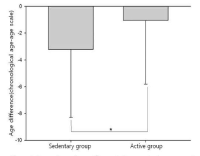
PURPOSE This study aimed to examine the associations between accelerometer-measured physical activity and both cardiometabolic disease risk factors and metabolic syndrome in Korean adults. METHODS We performed a retrospective cohort study with age-sex matched case-control using data from the 2014-2016 Korea National Health and Nutrition Examination Survey, which was administered to South Korean adults (n=320). Individuals were categorized into quartiles based on accelerometer-measured moderate-to-vigorous physical activity (MVPA). Demographic and physical characteristics, waist circumference, visceral adiposity index, blood pressure, lipid profiles, and TG/HDL-C were observed. The associations between MVPA status and cardiometabolic disease risk factors as well as metabolic syndrome were determined using multiple logistic regression. RESULTS For the waist circumference, SBP, DBP, MBP, visceral adiposity, triglyceride, and a surrogate estimate of insulin resistance, the Q1 and Q2 groups had higher means compared with the Q3 and Q4 groups. HDL-C was higher in the Q3 and Q4 groups compared to the Q1 and Q2 groups. Odds ratios for cardiometabolic disease risk factors and metabolic syndrome decreased in a curvilinear manner with the increasing quartile of MVPA. CONCLUSIONS Adults with higher MVPA participation were strongly associated with cardiometabolic disease risk factors and metabolic syndrome.
Circadian rhythm (CR) is an intrinsic process that changes in a cycle of approximately 24h/day to maintain body homeostasis. It is mainly controlled by the central command through the suprachiasmatic nucleus, and modern society features can disturb the central CR, contributing to various diseases. Recent studies have provided evidence that extrinsic factors, such as regular physical activity (RPA) and timerestricted feeding (TRF), can also alter the CR peripherally, emphasizing RPA and TRF as the non-therapeutic methods for circadian misalignment (CM). Therefore, this review scrutinizes the regulatory mechanism of CR and summarizes the relationships between CM and various diseases. In addition, by reviewing studies investigating the prevention or improvement of CM via RPA and TRF, the value of circadian biology research that can directly affect health, physical function, and lifespan is summarized. By introducing the scientific evidence for RPA and TRF to maintain and improve CR, we tried to emphasize the importance of regular exercise and healthy eating habits to people in the modern world who have difficulty maintaining CR.

Purpose The purpose of this manuscript was to investigate the effect of high and low speed blood flow restriction versus non-blood flow restriction isokinetic exercise on isometric muscle strength, muscle fatigue, and muscle contraction displacement. Methods The subjects were consisted of ten males without non-specific muscular skeletal disease. They were classified into four training groups: ① high speed(300°/s) without blood flow restriction, ② high speed(300°/s) under blood flow restriction, ③ low speed(90°/s) without blood flow restriction, ④ low speed(90°/s) under blood flow restriction. Before and after the intervention, all of the subjects underwent measurements of isometric quadriceps strength, muscle fatigue, and muscle contraction displacement. Results In regard to isometric quadriceps strength before & after intervention, there was no significant difference between groups. For the lactic acid measurement before & after intervention, there was a signigicant difference between groups(p<.05). Also, there was a significant difference between groups(p<.05) in muscle contraction displacement in terms of Dm but there was no significant difference between groups in terms of Tc Conclusions Isokinetic exercise with blood flow restriction had effects on lactic acid and muscle contraction displacement.


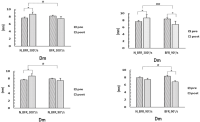

Purpose Sport has become a popular platform for corporate social responsibility (CSR) campaigns. Growing numbers of athletes, teams, and organizations are engaging in CSR campaigns to promote awareness and behaviors to support CSR campaigns addressing pressing social issues (e.g., disease prevention, health promotion, etc.). However, much of the previous work has focused on whether such initiatives benefit the organization, but not the community. The present paper provides theoretical explanations on the psychological mechanism that can demonstrate how consumers respond to CSR campaigns initiated by a sport organization. Method In particular, existing literatures in moral psychology and CSR have been reviewed to identify an explanatory mechanism that promote prosocial behavior among sport consumers. Results The present paper posits that moral emotion is a central processing mechanism explaining the link between CSR and socially responsible behaviors in consumers. The paper also provides a theoretical account to explain how moral emotions are evoked in the CSR context and how they can prompt prosocial behaviors. Conclusion This paper adds to the literature by answering the call for the need to understand underlying mechanisms linking CSR with positive social outcomes (cf. Aguinis & Glavas, 2012).

Although delayed heart rate recovery (HRR) and impaired autonomic nerve system (ANS) modulation after acute exercise are related with cause of cardiovascular disease (CVD) and mortality, studies evaluating ANS changes with local exercise are still unsatisfied. Thus, this study aimed at investigating the modulation of ANS-related parameters, followed by upper or lower body exercise. Eleven male without cardiovascular and orthopedic diseases measured basic body composition, resting blood pressure (BP), and heart rate variability (HRV). This study based on randomized cross-over design; AE composed with arm-ergometer, and LE involved with leg cycling. Participants had at least one week wash-out between each exercise, also there was no cool-down after exercise. All sessions were performed with intensity of 50 % target heart rate for 30 min. With measurement of Rating of perceived exertion (RPE) during every 10 min, HRV was measured Kubios HRV software using R-R intervals collected with Polar RS800CX in post-exercise recovery (for 30 min). As a result, heart rate (HR) and RPE were same (p > 0.05) through the experiment. As results of this study, SDNN and rMSSD in time domain on LE were higher than on AE during post-exercise recovery. When LE compared with AE used by Poincare plot, both parasympathetic reactivation (SD1) and autonomic nerve regulation (SD 2) on LE were higher than AE. Immediately after submaximal exercise, the high-frequency component on LE was significantly greater compared to AE. Also, the LF/HF ratio and LF nu reflecting sympathetic activity were higher on AE than LE. In contrast, the HF/TP ratio and HF nu reflecting vagal tone were greater on LE than AE. In conclusion, this study suggested regional lower body exercise recovers more sufficient than regional upper body exercise after submaximal aerobic exercise at same HR. Local exercise like leg cycling needs a careful approach to apply for accurate exercise prescription and effective training.

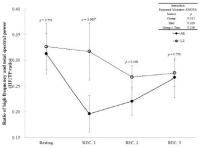
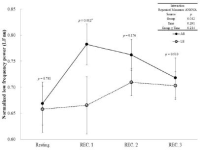
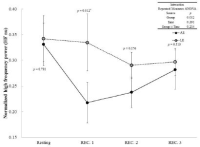
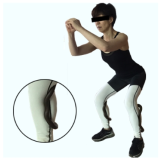
Purpose This study was designed to investigate the effects of weight-bearing exercise and CareRing treatment on cardiovascular responses, popliteal vein functions, and vascular elasticity of 30-40s women who had worked longer than eight hours a day in a standing position. Methods Thirteen subjects participated in 30 min of standing up treatment (STAND), weight-bearing exercise treatment (EX), and weight-bearing exercise with CareRing treatment (EX+RING). Each subject took part in the three trials repeatedly in a counter-balanced order and proceeded with a wash-out period of at least one week between the respective trials. Results The main results were as follows: 1) Significant reduction in EDV, no change in the diameter of popliteal vein, trend of reduction in blood flow of popliteal vein, and increased baPWV, indicating reduction of vascular elasticity of whole body, were shown in the STAND. 2) CO and EF increased significantly, and TPR decreased significantly in the EX. Blood flow velocity and blood flow volume of popliteal vein increased significantly, and baPWV decreased significantly from immediately after the treatment throughout the recovery phase in the EX. 3) HR, CO, and EF increased significantly in the EX+RING. Blood flow velocity and blood flow volume increased significantly in the EX+RING. Diameter of popliteal vein increased significantly immediately after the treatment and decreased significantly at 40 minutes of recovery. TPR and baPWV decreased significantly immediately after treatment compared to the STAND. Conclusions It was concluded that weight-bearing exercises would be effective in preventing venous or cardiovascular diseases occurred due to long-standing in 30-40s women, who are at high risk for such diseases. Furthermore, it would be more effective to combine pressure treatment with CareRing during weight-bearing exercises.


Purpose Osteoporosis is a systemic metabolic bone disease characterized by gradual decrease of bone mass and damage of the bone microstructure. In particular, postmenopausal osteoporosis is the most common type in women after menopause. This study aims to investigate the effects of combined exercise training on bone mineral density (BMD) and OPG/RANKL mRNA levels in ovariectomized rats. Methods A total of 40 Sprague-Dawley female rats were randomly divided into four groups: (1) CON (sham-operation, n=10), (2) OVX (ovariectomy, n=10), (3) OVX-REX (ovariectomy-resistance exercise, n=10), and (4) OVX-ARE (ovariectomy-combined aerobic and resistance exercise, n=10). Combined exercise training was performed on a treadmill and ladder adapted to rats in alternate days (4 days/wk, for 12 wk). Results Compared to the OVX group, all exercise treatments increased BMD and bone breaking force(p<0.05). In the bone turnover markers, serum C-terminal telopeptides of type-1 collagen (CTX-1) was significantly decreased in the exercise groups compared with OVX group and osteocalcin (OC) level was increased in the exercise groups (p<0.05). Additionally, in the exercise groups, expression of OPG mRNA was significantly increased compared with OVX group (p<0.05), and RANKL mRNA was slightly decreased but no significant between groups. Furthermore, OVX-ARE group showed more effects than OVX-REX group. Conclusions These results suggest that combined exercise may be a more effective therapeutic strategy to prevent and delay postmenopausal osteoporosis than resistance-only training.

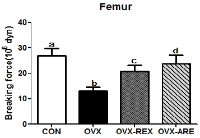
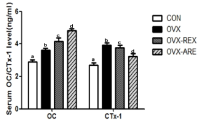
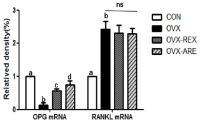
Purpose This study is a phenomenological research which tries to describe the subjective experience and to analyze multi-layered meanings, and it finds out the men's training experience and meaning. The purpose of this study is to investigate why the men do Yoga and what the subjective meaning of Yoga experience, and the study examines critically whether Yoga experience especially focused on women is against gender performance and dominant body discourse. Methods For the study, 6 middle & young-old aged men who do Yoga more than 6 months every week are selected as participants. Results The meaning of Yoga for middle & young-old aged men in their lives is as follows. First, it is hard for men to experience Yoga because of social and cultural background. Finding Yoga class which takes men's membership is difficult. Second, middle & young-old aged men's physical feature(interest in their health and disease) and personal background(women friendly daily life) become specific motivation to overcome the barrier to do Yoga. Third, Yoga is 'alterative training', not a training. Yoga is considered as a training which replaces the feature of training called men's sports previously. Fourth, Yoga has a meaning of 'healing' to have our own time. Fifth, Yoga is changed by itself in Yoga culture which is focused on women even though middle & young-old aged men do Yoga for a long time. Sixth, middle & young-old aged men realize that the feature of Yoga is not 'for only women', and they thought it is 'neutral training that men can do too.' Conclusion Consequently, the reason why middle & young-old aged men do Yoga is started from the motivation regarding physical characteristics and personal background, and the main purpose is to cure and to heal our bodies and mind. For them, Yoga means 'alternative training to fit their bodies' and 'their own time'. Moreover, old male adult's training experience and meaning are against gender performance in that it cause a crack in stereotyped gender sports area, but it is notable that there is no intention to resist the dominant gender body discourse.